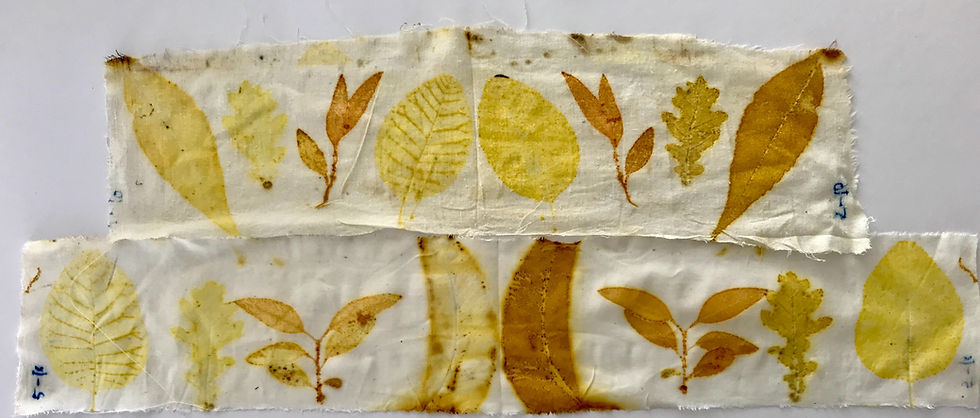5 Different Mordants in Eco Printing
- Suzanne Dekel
- 19 apr 2021
- 4 minuten om te lezen

In several previous blogs you have been able to see and read more about the different results in natural dyes when using different mordants.
In this blog I want to show you the results in reference to eco printing. The natural juices and tannins present in the leaves leave different prints on fabric and paper when using different mordants. Looking deeper into this will also help understand the effect the mordants have visually on our natural dyes.
First; we will look at the way leaves are built.
Leaves are collectively referred to as foliage. In eco printing we often speak of a sun- and a moon side of the leaf. Officially we call the upper adaxial surface as opposed to the lower abaxial surface. Most leaves have a very clear distinction between the two surfaces with differences between the number of stomata (pores), wax, hairs and colour.

Example; on a birch leaf we clearly see the darker photosynthetic tissue on the upper side of the leaf, while the down side is lighter, and has more pores.
Some plant types like Eucalyptus are isobilateral, meaning both sides of the leaf have photosynthetic tissue present, this means they will print practically equally on both sides of the leaf.
The leaves;
For this research I used what's growing abundantly behind my house;
Pecan
Eucalyptus porosa
Oak
Cotinus (smoke bush)
I used leaves that were picked fresh (and left them for about a day because things came up) in the fall season. Using spring or summer leaves will give slight differences in colour because of fluctuating tannin levels in the seasons.
The mordants
Safety precautions, health hazards and environmental issues.
Never handle fine powders without a face mask. Do not use mordants without gloves. Do your homework and read up about health issues related to mordants, safety sheets are readily available on the internet. Be careful when handling hot liquids. Dispose of mordant leftovers in a safe and responsible way according to your local ordinances.
Aluminium Tri Formate and Titanium Oxalate should never be heated beyond 70ºC. Basic knowledge about mordants and assists has been discussed here. This is not the place to discuss increased lightfastness or wash fastness after using mordants. All mordants do this.
We are using some basic mordants that are also available on the website (here) as well as some things I use for 'special occasions". I wrote down the WOF I used next to each mordant, which is a median amount. You are free to play around with this at will. Using very subjective descriptions for the shading effect of different mordants we can say the following;
1 Aluminium based mordants are called sunny mordants, the interaction of Alum with the natural tannins in leaves and dye brings out yellows and bright greens. For this round I used Aluminium tri-formate because I can use it on protein and cellulose fibers so it saves me an extra round of prepping. I have a fresh 2% solution on 2 liters of water for this.
2 Ferrous Sulfate is called the sad mordant, it brings out the grays and blacks when interacting with the natural tannins present in the natural dye or leaf pigment. WOF 1%
3 Copper Sulfate is a saddening mordant, it brings out the greener and blueish hues when reacting with the tannins leaves and natural dyes. Used here at WOF 4%
4 Titanium Oxalate is a relatively new mordant, it was introduced first in the leather industry as a more environmental friendly alternative to the extremely polluting chrome mordants. It brings out orange and yellow hues when reacting with tannins.
On protein fibers we can use 10% WOF and dye or print straight after that. (For cellulose a reverse process is recommended: first dye and then use a 5% WOF after mordanting of Titanium Oxalate.)
5 Tin is called the red mordant and is not so often used in ecoprinting, mostly because it is extremely pricey. In natural dyeing it is historically THE critical ingredient to get flaming reds from cochineal. I get mine from Amazon, in small quantities for experiments only. Use at 2% WOF is enough.
I mordanted the following way; dissolve the powder with a bit of wam (60ºC) water and top up with cold. Stir the fabric well with the mordant, and again after a few hours. Leave overnight, stir and rinse.
After mordanting we can already see a difference in hues between the different samples, caused by the natural shade of the mordants. For abbreviations look here.


Measuring these teeny tiny amounts of mordants is not so simple, I use a special scale I got from one of the large online stores that they use for drugs and diamonds. It measures up to 200 grams with 0.01 precision, so it is perfect for measuring 0.17 of ferrous sulfate etc.
I made separate bundles with two pieces of silk (matka and a broadcloth) for each mordant, with the same sequence of leaves. I used recycled plastic as a barrier for each sample. Steamed all together for 90 minutes in the Big Mother, my 90 cm silk steamer.
The results when finished, hanging to dry

Results per mordant;
1 Aluminium Tri Formate

2 Ferrous sulfate

3 Copper sulfate

4 Titanium Oxalate

5 Tin

It is possible of course, to combine these mordants, I have made one sample to show this where I combined Titanium Oxalate with Ferrous sulfate. The possibilities are endless.

Feel free to share your results!
























